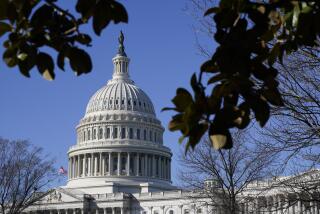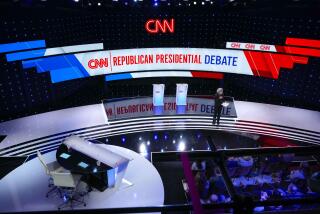Everyone is ‘sick of watching’: Political ads overwhelm North Carolina

Running for state treasurer, Ronnie Chatterji’s folksy 30-second TV spot confronts one of the key issues in this battleground state.
“Look, I can’t make these ads stop,” the Democrat admits, looking into the camera. “You can make this one stop,” pleads his daughter, who plays on a swing. His young son calls the ad “Boooring!”
If the spot hits a nerve here, it’s because North Carolina has been swamped by more political ads than any other state — with a jaw-dropping 7,000 ads broadcast on Wednesday alone in a state with only six small to medium television markets.
The nonstop, back-to-back ads blizzard the airwaves, an onslaught that has cost more than $500 million across all races. That tops every state except California, which has four times the population, 14 more television markets and a dozen statewide ballot initiatives.
Across the country, candidates for state, local and national office have spent a staggering $7.8 billion on television and digital advertising this election cycle, according to an analysis for The Times performed by Advertising Analytics, a research firm that tracks political advertising.
That’s not just more than the annual gross domestic product of many small countries. It’s about triple the amount of money spent for political ads four years ago, a sign of the fervor — and anxiety — that surrounds this year’s election.
Here in North Carolina, voters say they feel bombarded to the point of numbness, not just when they watch TV or scroll Facebook, but by the half a dozen fliers that jam the mailbox each day, all aimed at the sliver of still-persuadable voters who haven’t yet decided or cast their ballots.
“How anybody can be undecided at this time… I really don’t know,” said Jeff Jones, 60, who owns a heavy equipment business in Raleigh. The onslaught of ads, he said, “just probably make more people sick of watching.”
The unprecedented ad war has exploded here because North Carolina is not just a battleground state for President Trump and former Vice President Joe Biden but for other potentially crucial races up and down the ballot.
The Democratic governor, Roy Cooper, faces a reelection battle. Sen. Thom Tillis is among the most vulnerable Republican incumbents in the country and his challenger, Cal Cunningham, could swing control of the Senate to Democrats if he wins.
The two candidates and outside groups have spent about $250 million in that race, the most expensive Senate campaign in the country.
Negative ads from the two campaigns sometimes alternate on afternoon TV and local news broadcasts.
Cunningham’s Senate campaign is “one big lie!” his opponent charges. Tillis “always backs Big Pharma!” and is “corrupt!” his rival responds.
In between, ads appear about state Senate candidates supposedly trying to take away healthcare — the dominant theme in Democratic attack ads here — and a state representative who “wants to defund our local hospital.”
There’s a retired Air Force colonel who “put herself on the line for us” and is now fights a politician who votes with “special interests.” Another spot slams a candidate for attorney general who “routinely let criminals walk free.”
A recent scandal for Cunningham involving adulterous text messages has given Tillis, who is trailing in the polls, a lot more fodder.
In one, paid for by American Crossroads, a super PAC that backs Republicans, a young woman sneers into the camera and says Cunningham’s infidelity “tells me everything I need to know about Cal’s character.” Another ad features military veterans questioning Cunningham’s honor.
In the presidential race, Trump has almost no path to reelection without winning North Carolina’s 15 electoral votes. Polls show he is trailing Biden in the state, where the two campaigns and outside groups are locked in an ad war that has cost $162 million so far.
And thanks to court-ordered redistricting, Democrats are expected to pick up at least two U.S. House seats and may flip the state Legislature. Seven separate state House and Senate seats have spent more than $1 million each, a sum once unheard of in such small races.
It’s hard to say what the candidates and donors are getting for their money, especially as the ads bump up against one another.
A study published last month in the journal Science Advances, which relied on data from 34,000 voters, found that political ads had only a negligible effect in the 2016 presidential election, with only 0.7% of people changing their opinions on whom to vote for.
“Partisan group identity is just a very powerful choice for voting,” said Alexander Coppock, the study’s lead author and an assistant professor of political science at Yale University. “You just can’t move people that much with an ad.”
In a close election, a small margin could matter. Other studies have shown that ads can produce a much greater influence on down-ballot races, where the candidates and their positions are less known.
Chatterji, the candidate for state treasurer whose children mock him in his ad, is making his first bid for public office. An economist who teaches business and politics at Duke University’s Fuqua School of Business, he’s not sure how many people see his ads.
“The truth is nobody knows,” he said.
In the end, he may have found something more effective than a clever script or an attack — cute kids.
“People come up to me and say, ‘I saw your ad and your kids are going to win this election for you,’” he said.
More to Read
Get the L.A. Times Politics newsletter
Deeply reported insights into legislation, politics and policy from Sacramento, Washington and beyond. In your inbox three times per week.
You may occasionally receive promotional content from the Los Angeles Times.







